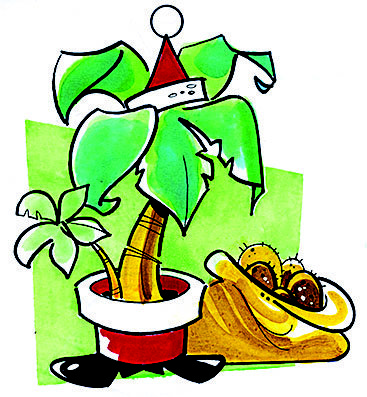Q I have potted palms in metal urns on my north-facing, well-covered front porch in Dumas that I'd like to overwinter without moving them. The porch is 10 feet deep, open on the ends and is as wide as the house. Do you think they would make it through winter? How do I care for them?
A It depends on what type of palms they are. We have several varieties that are winter hardy in various parts of Arkansas. The windmill palm should survive statewide. In Dumas, you should have luck with several others, including the sago palm, date palm, sabal and pindo palms. If you have the large, houseplant-type palms -- parlor palm, Kentia palm or fishtail palm -- they would not survive outside, even with protection in south Arkansas, unless it is a very mild winter. I would opt for replanting with a hardy variety next year. Then you wouldn't have to worry.
Q I really appreciated your article in the paper about crape myrtle bark scale. In your article you recommend three treatments: 1.) Wash with warm soapy water. (I have already done this.) 2.) After the leaves fall, treat with dormant oil. (I purchased "All Seasons Horticultural & Dormant Spray Oil" and I am just waiting for the leaves to fall to do this step.) This may be somewhat difficult since my crape myrtle is very tall and I am not sure how to reach the top branches, but I will do my best. 3.) It is the third step that I am unclear on. It says in late March through early May, to treat with a systemic insecticide containing imidacloprid (Merit or Bayer Advanced Tree and Shrub Insect Control), thiamethoxam (Meridian) and dinotefuran (Green Light Tree and Shrub Insect Control with Safari). Are you saying that we need to use any one of these three products, or are you saying that we need to use all three?
A Do your best when it comes to spraying with the dormant oil, but coverage is greatly improved after the leaves have fallen, so there is nothing to get in the way. As for the systemic insecticides in Step 3, use only one of the products, not all three.
Q I have a schefflera that began as a small-to-medium-size potted plant a few years ago. We have repotted it three times, each time to a much larger pot. It has now grown to a large tree but is still in a pot. We just moved it into the garage for the winter and will keep it there until the maple tree that we keep it under leafs out again next spring. Since this has grown so large, would it be possible that it would overwinter next year if I planted it in the ground next spring? We live in Beebe. It has a huge root ball and rather large limbs now, and it is absolutely gorgeous. I certainly don't want to lose it, but it is quite hard to handle when repotting since it has gotten so large. It is 7 or 8 feet tall.
A Scheffleras are tropical plants and would not survive anywhere outside in Arkansas. In the future, if your plant is root-bound, instead of increasing the pot size with each repotting, shear off some of the roots and repot in the same container with fresh soil. This alleviates the root-bound conditions but limits top growth. As you upgraded each year, you gave the plant carte blanche to grow bigger.
Q I bought some bittersweet at a craft fair to use in a fall wreath and stored it after the season. When I opened the box, I had a bunch of seeds. How and when can I plant them?
A Bittersweet seeds need to be planted in the fall outdoors so they can get the cool, moist temperatures they need to germinate. Or you can do this stratification artificially by storing the seeds in a plastic bag filled with moist potting soil in your refrigerator for the winter and then plant outside in the spring. The seeds should grow quite readily after the stratification process. There is one drawback to growing bittersweet from seed. It will take a few years before they are mature enough to flower. Only then will you know if you have male or female plants, and you need one of each to get fruit.
Janet B. Carson is a horticulture specialist for the University of Arkansas Cooperative Extension Service. Write to her at 2301 S. University Ave., Little Rock, Ark. 72204 or email her at
HomeStyle on 12/03/2016

